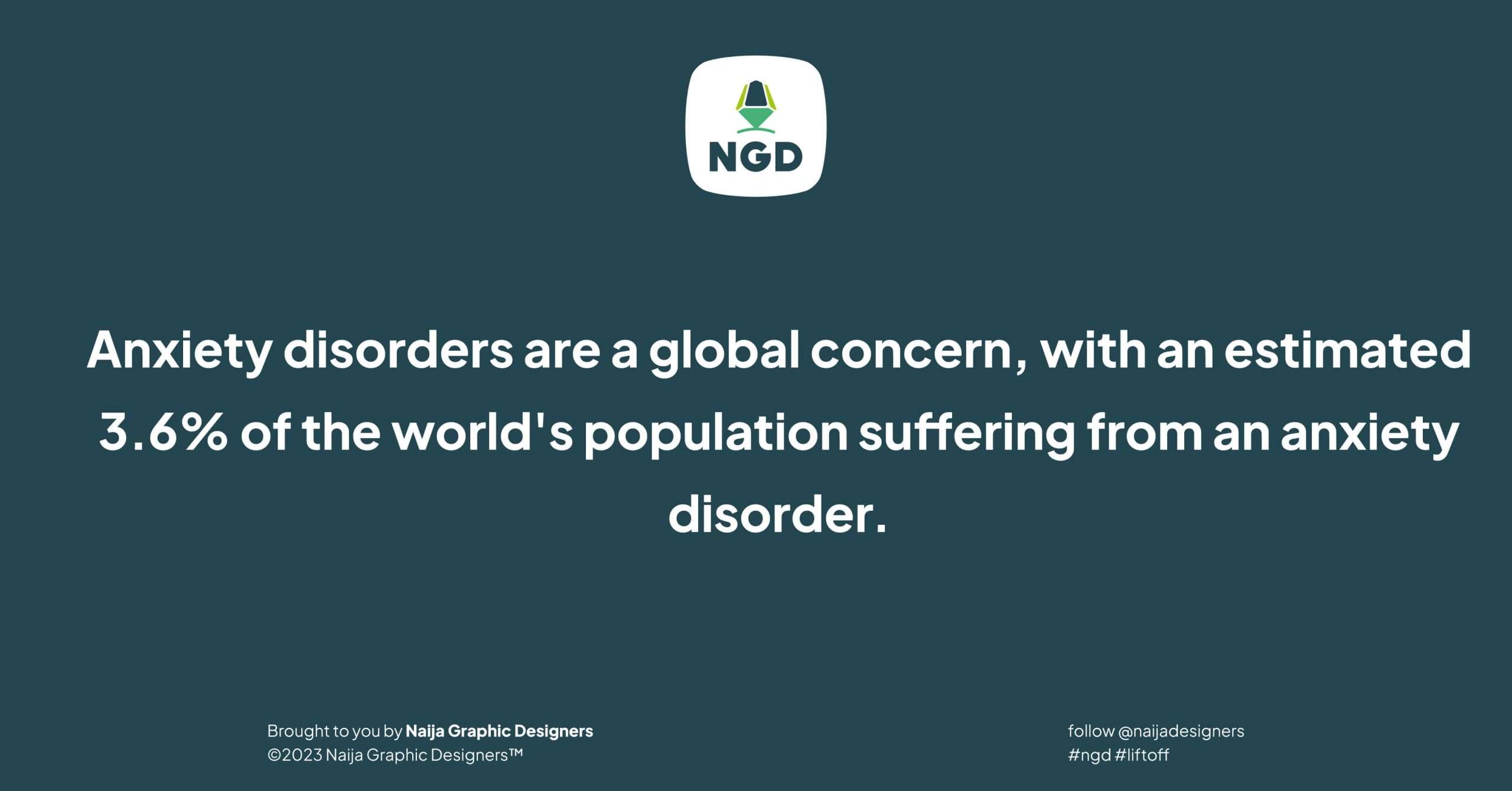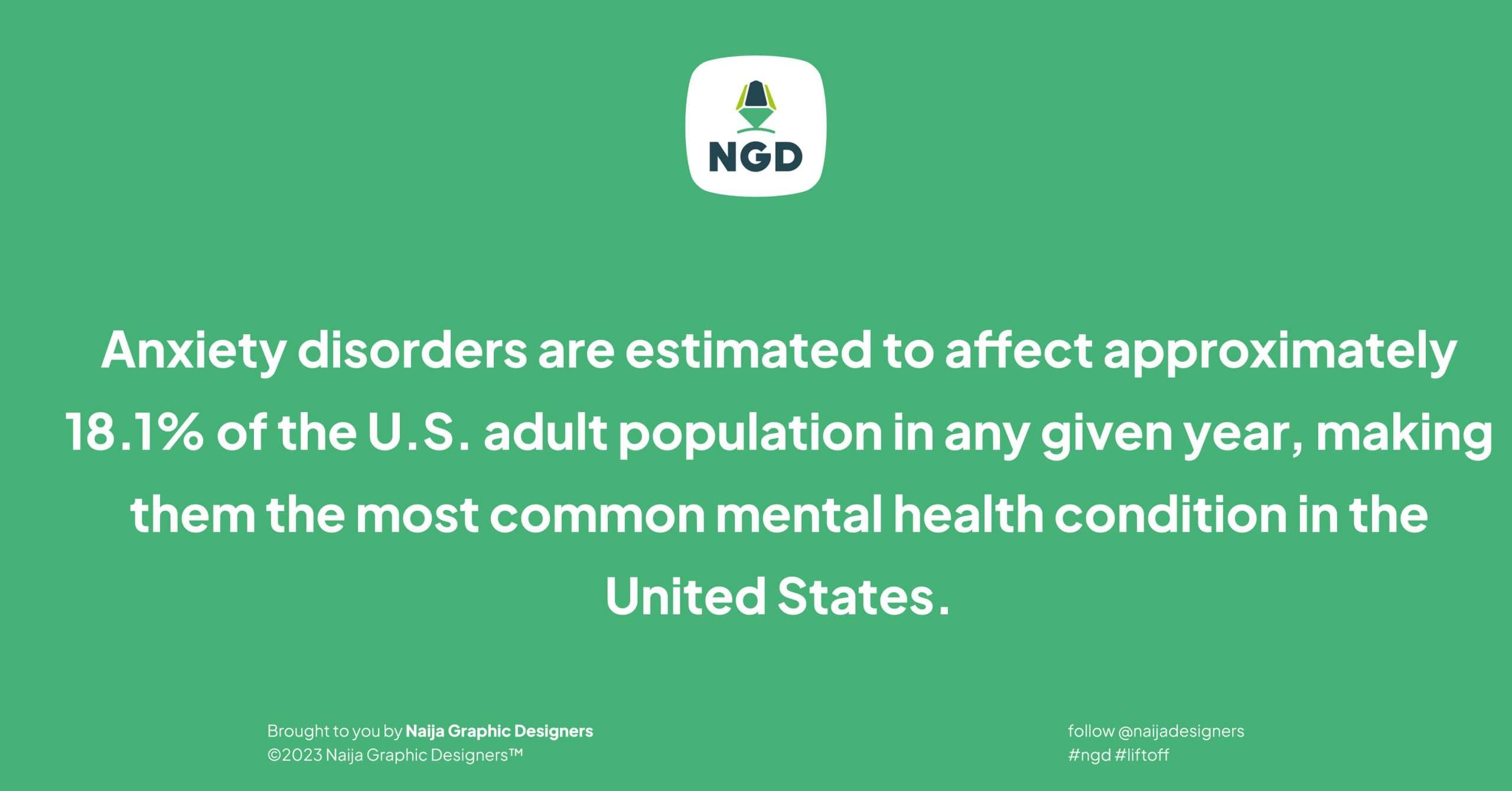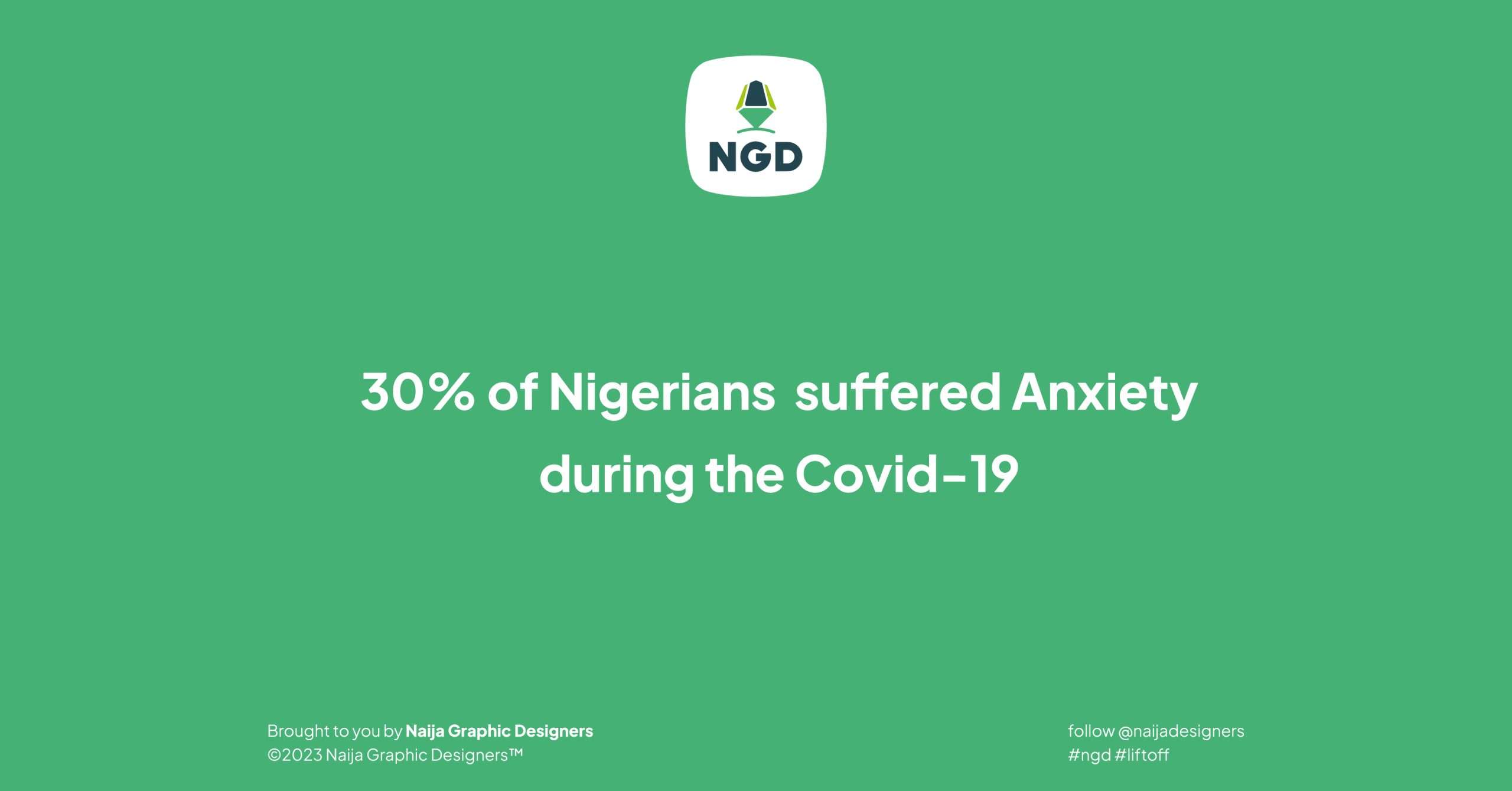Worried about an event that hasn’t happened or dwelling on thoughts that make your toes curl? Then you might be experiencing anxiety, a state of constant worry, the inability to control worrisome thoughts or the avoidance of unpleasant conditions.
It’s a mental disorder common to all professional fields but studies like the 2011 Swedish study by Simon Kyaga, a senior psychiatry consultant suggest anxiety is more common among creative work types like photography, writing, and, of course, graphic design. There are several reasons for this. Writer Radhika suggests that the use of imagination to conjure up possibilities before they occur could be associated with creatives easily imagining worst-case scenarios. Again, another thought suggests the mere process of creativity, i.e., coming up with new ideas, is a stressor in itself, and when combined with unfavorable situations, promotes anxieties.
How exactly does anxiety work and what are the five telltale signs
Believe it or not, the core function of anxiety is preservation, as described by Tangible Day. Its goal is the release of stress hormones responsible for heightened awareness and solution of challenges.
Here’s how anxiety in a normal situation works.
Perception of Threat: Anxiety typically begins with the perception of a threat, whether real or imagined. This threat can be physical, emotional, or psychological. It triggers the brain’s “fight or flight” response, which is a survival mechanism that prepares the body to respond to danger.
Brain Involvement: The amygdala, a small almond-shaped structure in the brain, plays a central role in processing emotions, including fear and anxiety. When the brain perceives a threat, the amygdala sends signals to various parts of the brain and body to prepare for action.
Release of Stress Hormones: The amygdala signals the hypothalamus to activate the body’s stress response system. This results in the release of stress hormones, primarily adrenaline and cortisol, into the bloodstream. These hormones prepare the body for immediate action.
Physical Response: The release of stress hormones has several physical effects on the body. These include increased heart rate, rapid breathing, increased blood pressure, heightened alertness, and heightened muscle tension. These changes are designed to help the individual respond quickly to the perceived threat.
However, ongoing, intense or hard-to-control anxiety are simply out of proportion could be a sign of a mental problem. In such cases, anxiety works in this manner:
Emotional and Cognitive Response: Anxiety also has an emotional and cognitive component. Individuals experiencing anxiety often feel a sense of unease, worry, or fear. They may have racing thoughts, difficulty concentrating, and a heightened awareness of the perceived threat.
Behavioral Responses: In response to anxiety, people may exhibit various behaviors. These can include avoidance of the perceived threat, seeking reassurance, or engaging in safety-seeking behaviors. In some cases, anxiety can lead to avoidance of situations or activities that trigger anxiety.
Feedback Loop: Anxiety can become a feedback loop. When a person perceives a threat and experiences anxiety, the brain may reinforce this response. If the perceived threat resolves without harm, the brain can still associate similar situations with anxiety, leading to future episodes of anxiety even when the threat is minimal or non-existent.
Chronic Anxiety: In some cases, anxiety can become chronic, evolving into an anxiety disorder. These disorders involve excessive and persistent anxiety that interferes with daily life. Examples include generalized anxiety disorder, social anxiety disorder, and panic disorder.
Sources Of Anxiety For Creative People And How To Solve Them
1. Perceived Successes Of Others
This anxiety often stems from comparing yourself to peers who appear to be thriving in the same profession, a phenomenon known as professional envy, as highlighted in the Harvard Business Review. It’s common for creative professionals, facing a lack of clients and projects to question why they aren’t experiencing success when colleagues are winning the client game thus leading to feelings of insecurity and self-doubt. If these thoughts persist, they can escalate into full-blown anxiety, accompanied by overwhelming feelings of failure and unworthiness.
What to do: To navigate this situation more positively, consider using the success of others as a source of inspiration and self-assessment. For instance, if a colleague excels in UI/UX gigs and earns significantly from them, view this as an encouraging indicator of the earning potential of your UI skill. This perspective contrasts with perceiving others’ achievements as threats or reminders of inadequacy, which can transform them into what’s often referred to as the “green-eyed monster.” This perspective shift can make it easier to genuinely celebrate the success of others without feeling diminished.
2. Deadlines
A recent survey from CareerCast found that deadlines are the No. 1 reason for workplace stress.The survey of 1,071 CareerCast readers found that almost 3 in 4 were experiencing higher-than-moderate stress in the workplace. Respondents were asked to rate their job stress levels on a scale of 0 to 10, with 0 denoting no stress and 10 signifying constant stress. Seventy-one percent of respondents said their jobs involved a stress score of 7 or higher.
The survey found that the most common cause of stress was deadlines (30 percent). The second most common was being responsible for the lives of others (17 percent), followed by competitiveness (10.2 percent) and physical demands (8.4 percent).
Deadlines are a feature of the creative world, with every project bearing a significant date for it’s closure. Creatives working close to deadlines experience heightened stress at the thought of failing to deliver at due dates and the consequences arising therefrom.
Deadlines can be avoided as a source of anxiety. Here’s how to eliminate them:
- Set Realistic Dates: Avoid falling victim to the optimism bias, a tendency to underestimate the time needed for tasks. When managing deadlines, it’s essential to consider every aspect of a project, from conceptualization to execution. Failing to account for the depth and complexity of a project and setting unrealistic close dates can lead to detrimental consequences. Not only will the project likely remain incomplete within the given time frame, but it will also pave the way for anxiety. External pressures, whether from colleagues or clients, should not coerce you into accepting impractical deadlines. It’s crucial to communicate openly about the project’s timeline and educate others about the necessary time for quality work, thus reducing anxiety-inducing pressures.
- Use Time Management Techniques: Embrace effective time management techniques that can significantly aid in meeting deadlines and minimizing anxiety. One valuable approach is the Pomodoro Technique, which involves working in focused, timed intervals with short breaks in between. Structuring your day with specific time blocks for various tasks can help you stay organized and on track. Digital tools and apps designed for time tracking and management can provide additional support in managing your workload efficiently.
- Combat Procrastination: Procrastination often exacerbates anxiety related to impending deadlines. Identifying the root causes of your procrastination is a crucial step toward overcoming it. These causes may include fear of failure, lack of interest, or feelings of overwhelm. To address these issues, engage in self-reflection and consider seeking support, whether through self-help strategies or professional assistance. Initiating tasks by tackling the most challenging one first, a strategy known as “eating the frog,” can build momentum and reduce the tendency to procrastinate.
- Practice Stress-Reduction Techniques: Managing anxiety associated with deadlines requires incorporating stress-reduction techniques into your daily routine. Engage in activities such as regular exercise, meditation, deep breathing exercises, or mindfulness practices. Maintaining a healthy work-life balance is equally important.
3. Toxic Co-workers
Toxic coworkers can be a significant source of anxiety in the workplace. Their disruptive behaviors, ranging from constant criticism and undermining to engaging in gossip and rumors, create a hostile and stressful environment. The unpredictable nature of their actions, along with the potential for bullying or harassment, adds to the anxiety. Moreover, toxic individuals can disrupt team dynamics, making it difficult to collaborate effectively and fostering constant tension. The constant worry about how their behavior may impact your job performance and reputation can erode self-confidence and lead to persistent anxiety. Managing and minimizing this anxiety often requires setting boundaries, seeking support, and prioritizing self-care while considering formal actions when necessary to address the toxicity and regain a sense of workplace well-being.
To manage anxiety caused by toxic coworkers, consider the following strategies:
- Set Boundaries. Establish clear boundaries with toxic coworkers. Politely but assertively communicate your limits and expectations regarding their behavior. Avoid engaging in negative interactions or responding to provocations.
- Document Incidents. Keep a record of any incidents involving toxic coworkers, including dates, times, and details of their behavior. This documentation can be valuable if you need to escalate the issue to a supervisor or HR.
- Seek Support: Talk to colleagues or supervisors you trust about the situation. They may offer guidance, support, or advice on how to deal with the toxic individual. Sometimes, discussing the issue can alleviate some of the anxiety.
- Practice Self-Care: Prioritize self-care to reduce the impact of workplace anxiety. Engage in stress-reduction techniques like meditation, exercise, and deep breathing. Make sure to get adequate rest and maintain a healthy work-life balance.
- Maintain Perspective: Remind yourself that toxic coworkers’ behavior is a reflection of their issues, not your worth or abilities. Try to distance yourself emotionally from their negativity.
- Exit Strategy: If the toxicity persists and severely impacts your well-being, consider exploring other job opportunities. Your mental health and well-being should be a priority, and sometimes leaving a toxic work environment is the best option.
4. Burnouts
Burnout can create anxiety through a complex interplay of physical, emotional, and cognitive factors. The prolonged exposure to chronic stress and overwhelming work demands leads to physical exhaustion, manifesting as fatigue, sleep disturbances, and headaches. This physical discomfort can, in turn, trigger anxiety as individuals worry about their health and ability to cope. Emotionally, burnout fosters distress, including feelings of helplessness, hopelessness, and irritability. These emotions contribute to heightened anxiety as individuals struggle to manage their overwhelming feelings. Burnout also impairs cognitive functions, such as concentration and memory, making individuals more susceptible to anxiety-provoking situations and increasing their anxiety about their performance and competence.
Here are five ways individuals can manage burnout to avoid anxiety:
- Prioritize Self-Care: Make self-care a non-negotiable part of your daily routine. This includes getting adequate sleep, maintaining a balanced diet, and engaging in regular exercise. Self-care also involves setting boundaries to protect your personal time and mental well-being. By prioritizing self-care, you can replenish your physical and emotional resources, making it easier to combat burnout and the anxiety it can trigger.
- Practice Stress Reduction Techniques: Incorporate stress reduction techniques into your daily life. Techniques such as mindfulness meditation, deep breathing exercises, and progressive muscle relaxation can help manage stress and prevent it from escalating into burnout. Dedicate time each day to engage in these practices, even if it’s just for a few minutes, to promote relaxation and emotional balance.
- Seek Social Support: Don’t hesitate to reach out to friends, family, or colleagues for support. Sharing your feelings and experiences with trusted individuals can provide emotional relief. You may find that others have faced similar challenges and can offer valuable advice or simply lend a sympathetic ear. Building a support network can reduce feelings of isolation and help you navigate burnout more effectively.
- Set Realistic Goals and Boundaries: Assess your workload and responsibilities realistically, and set achievable goals and expectations. Avoid overcommitting or taking on more than you can handle. Set clear boundaries at work and in your personal life to prevent burnout from creeping in. Communicate your boundaries to colleagues and supervisors, and don’t be afraid to say no when necessary. Striking a balance between work and personal life is vital for long-term well-being.
- Take Time Off and Recharge: Regularly schedule breaks and time off to recharge both physically and mentally. Vacations, even short ones, can provide essential relief from work-related stressors and help prevent burnout. During your time off
5. Financial Instability:
Financial instability is a potent source of anxiety for creatives, casting a shadow over their artistic pursuits. This instability often arises from irregular income, unpredictable project flows, and the absence of traditional job benefits. Fluctuations in earnings, coupled with the ever-present uncertainty of when the next project will arrive, can create constant financial worry. The weight of irregular expenses, such as investments in creative tools or unexpected emergencies, adds to the anxiety. Creatives grapple with the dual challenge of pursuing their passions while navigating the precarious financial landscape of freelance or project-based work. The fear of financial instability can cast a shadow over their creative endeavors, making it essential for them to develop strategies for managing their finances and mitigating the stress and anxiety that often accompany this aspect of their careers.
Here are ways to manage financial instability for an anxiety-free life as a creative:
- Improve your marketing: Absent clients are often the source of financial instability but by learning new and proven ways of discovering clients like social media strategies for graphic designers , LinkedIn for designers or podcasting for building your reach you can solve the client drought and bringing in projects that keep your purse heavy.
- Budgeting and Financial Planning: Create a detailed budget that outlines your income, expenses, and savings goals. Be diligent about tracking your spending and prioritize essential expenses, such as bills and necessities. Allocate a portion of your income to an emergency fund to provide a financial cushion during lean times. Regularly review and adjust your budget to align with your financial goals and adapt to changing circumstances.
- Diversify Income Sources: Relying solely on one income stream can increase financial instability. Consider diversifying your income sources by exploring various creative projects, freelance opportunities, or part-time work.
- Practice Mindful Spending and Lifestyle Adjustments: Evaluate your spending habits and identify areas where you can cut back without sacrificing your quality of life. Practice mindful spending by distinguishing between needs and wants. Consider making lifestyle adjustments, such as downsizing or reducing discretionary expenses, to align your lifestyle with your financial goals. This proactive approach can help you maintain financial stability and reduce anxiety about money matters.
6. Self-doubt and Imposter Syndrome
Self-doubt and imposter syndrome are common challenges that individuals, including creatives, grapple with in various aspects of their lives. Here’s an exploration of these concepts:
Self-Doubt: Self-doubt is the internal questioning of one’s abilities, decisions, or worth. It often stems from a lack of confidence and manifests as skepticism about one’s competence or potential. In the creative realm, self-doubt can manifest as uncertainty about artistic skills, creative ideas, or the quality of one’s work. It can hinder creative processes, lead to hesitation, and ultimately stifle creative expression.
Imposter Syndrome: Imposter syndrome is a psychological phenomenon where individuals, despite external evidence of competence and accomplishments, believe they are frauds and fear being exposed as impostors. Those affected by imposter syndrome tend to attribute their success to luck or external factors rather than their abilities. In the creative world, imposter syndrome can lead artists, writers, and other creatives to believe they do not deserve recognition for their work, causing anxiety and undermining their self-esteem.
Here’s some helpful tips for combating these sources of anxieties
- Self-Awareness and Mindfulness: Self-awareness is the first step in managing self-doubt and imposter syndrome. Recognize when these feelings arise and the situations or triggers that lead to them. Practice mindfulness techniques, such as meditation and deep breathing, to stay present and prevent spiraling into self-criticism. By acknowledging your thoughts without judgment, you can gain control over negative self-perceptions.
- Embrace a Growth Mindset: Cultivate a growth mindset, which emphasizes that abilities and intelligence can be developed through dedication and hard work. Understand that making mistakes and facing self-doubt are integral to the creative process. View challenges as opportunities for learning and growth rather than as indicators of incompetence.
- Seek Support and Feedback: Share your creative work with trusted peers, mentors, or fellow creatives who can provide constructive feedback and encouragement. Discussing your doubts openly can demystify imposter syndrome and make it easier to manage. Trusted support networks can offer reassurance and remind you that you are not alone in facing these challenges.
- Keep a Success Journal: Create a journal to document your accomplishments and positive feedback. Regularly review and update it to reflect your achievements, both big and small. When self-doubt creeps in, refer to this journal to remind yourself of your capabilities and the evidence of your competence. It can serve as a powerful antidote to imposter syndrome.
- Set Realistic Goals and Celebrate Progress: Break your creative journey into smaller, manageable goals. Celebrate your progress along the way, even if it’s incremental. By acknowledging your achievements, you reinforce your confidence and diminish self-doubt. Setting realistic goals ensures that you don’t set yourself up for unrealistic expectations that can fuel imposter syndrome.
Manage Anxieties and Live a Better Life
Anxiety disorders may have a deep-rooted connection to the brain, a phenomenon known as neuroplasticity. This can result in a persistent, fixed way of thinking that complicates the management of anxiety. Nevertheless, every creative has the opportunity to commit to identifying anxiety triggers and refraining from indulging anxious thoughts, regardless of how ingrained these patterns may be in their brain.
It’s crucial to recognize that not all anxious perceptions are detrimental; some can serve as valuable alerts to potential dangers. Therefore, it’s essential to assess your thoughts carefully, discern what truly matters, and promptly dismiss what lacks genuine significance in order to maintain a balanced approach to managing anxiety.
Need someone to talk to ? Start here


